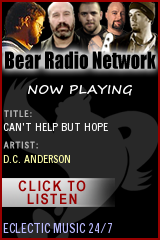Bear lovers: “Fur: The Love Of Hair” is just for you | VIDEO
by Ken Williams – SDGLN Editor in Chief
August 16th, 2012
It somehow seems appropriate that a new coffee-table book, Fur: The Love Of Hair, would be a heavyweight champion.
“Weighing in at 4.1 pounds hardbound with a dust cover, Fur is a stimulating and uniquely captivating guide to the hairy masculine physique,” said Ron J. Suresha of Connecticut, who co-authored the book with Palm Springs resident Scott McGillivray.
Photo captions
Top: Photo by Gino Possanza (Desert Hot Springs, Calif.): “Matt”
Middle: Illustration by Ray Conser (Jamul, Calif.): “Safe in His Arms”
Bottom: Photo by Douglas James Dick: “Andre”
+
“This huge, stunning homage to hirsute homomasculinity, just released from German publisher Bruno Gmünder, has 256 full-color pages of photographs, illustrations, essays and quotes from more than 50 contributors from around the world, including Jack Fritcher, Tom Bianchi, Minoru, Rex, Exterface, Pantheon Studios and Blade Bannon,” Suresha said.
The big book includes full-frontal nudity and furry posteriors, so keep that in mind when granny comes to visit.
If you are a bear or a fan of hairy-chested men, this book has you amply covered. The first quote, seen on the inside front jacket, comes from Sen. Joe Lieberman: “There is a constituency for chest hair.”
The senator is quite correct. At one time, men with mustaches, men with chest hair and men who were hyper masculine were put on a pedestal in the gay community. Then came the metrosexual era, and the shaving began. But Suresha said he sees evidence that hair is coming back. Five years ago, he co-founded Bear Bones Books, an imprint of indie LGBTQ trade book publisher Lethe Press, and business took off.
San Diego Gay & Lesbian News asked Suresha about the new book, about the bear community and other subjects.
SDGLN: Paul Rudd, Chris Evans, Jake Gyllenhaal. Is hair making a comeback?
Ron Suresha: Like hair, the list of fuzzy-wuzzy stars just keeps growing — great news for Bearish guys and fur-lovers of any gender.
Of course actors and performers will shave if they’re paid enough to do that — just look at furball Zach Galifianakis shaving his beard in his new movie.
I’ve noticed that scruffy, even shaggy men are now featured in lots of everyday primetime TV/cable commercials (like [DC Pierson] the Allstate “My bad!” guy), another cultural indicator for these sorts of things.
My absolute fav furry gay star is Rufus Wainwright, who’s proud of his fur and has even gone as far as critiquing Bon Jovi’s shaved chest.
SDGLN: Earlier in gay culture, our male role models tended to be hairy and macho. Why did hirsute heroes like the Village People and the Bee Gees, butch adult stars like Bruno and Ed Wiley, and actors like Sean Connery (007) and Ryan O’Neal go out of fashion?
RS: You’re telling me that Sean Connery went out of fashion?! There are some iconic furry men who have always been and will never will go out of style. I would say that there has been a slow but steady growth over the past quarter-century in cultural acceptance of body and facial hair. Witness the simultaneous proliferation of men’s hair care products and hair-removal procedures, now each a multimillion-dollar industry.
Over the past two and a half decades, the gay/bi men’s Bear magazines and media have been influential in the slow overall shift toward acceptance of body and facial hair. When you have a straight guy like Clerks director Kevin Smith on the cover of “A Bear’s Life” magazine (sadly now-defunct), and going on Letterman to flash the front cover and say that if other guys want to eroticize bearded, hairy, overweight men who look like Smith, more power to them — that to me signals a significant cultural shift. Many fine tiny hairs have sprouted and matured, and now we can see the forest through the trees.
SDGLN: In the book, you suggest that the advent of AIDS played a factor in why guys started shaving their mustaches and body hair. Explain further.
RS: Gay culture shifted in several directions in reaction to AIDS in the 1970s and ‘80s, when not just our homomasculine heroes and icons, but our furry friends and lovers, were taken from us.
One reaction was the Bear community expressing its love of fur, fat, gray, and all the other usual hormonal signs of male maturation, signifying health and survival. Think of Fuzzy in Longtime Companion.
Yet other, if not most, gay men continue shaving their beards and mustaches, and manscaping their chests and crotches, not just because shaving has been the norm in 20th-century men’s fashion and drag performance, but because these men feel that being smooth makes them look younger, sexier, and thus healthier.
SDGLN: Why is there a need for a bear community?
RS: Because older and mature gay, bi and queer guys should be free, if not encouraged, to organize spaces and events that meet their mutual homosocial needs, including their unique and mature sexual tastes, just like straight men and lesbians and bi’s and transgender folks are free to organize and associate socially.
SDGLN: What is the bear code, and is it widely used?
RS: The Bear Code was developed by two geek-Bears at the advent of the WWW in order to succinctly communicate a personal profile that included not only physical factors like beard length, hirsuteness and body type but also lifestyle/personality factors like “kink” and “Daddiness.” The Bear Code became obsolete with easy accessibility to post and view photos on the Internet.
SDGLN: What are the biggest social events for bears and their admirers?
RS: There are several events in the USA that regularly draw thousands of national and international visitors. Probably the largest I’ve ever attended was this year’s Bear Week in July, which according to one organizer drew 8,000 people to Provincetown spanning two weekends.
The Lazy Bear retreat in Guerneville, Calif. also pulls a crowd of several thousand. International Bear Rendezvous on Presidents Day Weekend in San Francisco used to do similarly, but the SF bear club has changed that event and I can’t say what they’re up to now.
The oldest events, such as TBRU (Texas Bear Round-Up) in Dallas and Bear Bust in Orlando, are still very popular annual destinations. And there are dozens of annual bear “runs” in Europe, Australia and elsewhere around the globe that draw hundreds [and thousands] of guys.
SDGLN: How has the public reaction been to your books celebrating the love of hair?
RS: Most folks are just kind of overwhelmed by the size of this massive hardcover full-color 256-page art book. Fur is a hefty 4.1 pounds and you can probably build muscle mass just by lifting a pair of the books.
Bruce Vilanch, whom I sent a copy, joked that he was going to build a new coffee table for Fur. And beloved Tales Of The City author Armistead Maupin graced us by coming to the Fur reading we did in P-town last month. His husband Chris, co-founder of leading online social network BearCentral.com, is a contributing photographer to the book. So it seems the artists in the book are pleased.
Grady Harp, a top Amazon reviewer, gave the book a 5-star rating and said, “top quality photography and illustration . . . in addition to the eroticism captured there is an overriding sense of fun and entertainment” That’s a lovely endorsement.
And what is your reaction to the book?
SDGLN: How did you choose the photographers as well as the photos and illustrations? Some photographers are well-known, other not. The imagery ranges from the innocent to the risqué, from G-rated to R-rated, and includes full frontal nudity.
RS: We sent out an exposé for Fur, inviting photographers and illustrators to submit samples of their work. My co-author, graphic designer Scott McGillivray, brought in many submissions from the West Coast, in addition to my contacts on the East Coast and the publisher’s European and worldwide roster of artists and photographers. We were sent more than 1100 images to choose from: old friends of ours, like Jack Fritscher and TJ Norris, who have some classic shots in the book, as well as many new and exciting artists whose artwork we loved.
We wanted to show a broad variety of body types, shapes, colors, and levels of furriness, so diversity was a factor. Scott made the initial art selections, and we then chose together a more-or-less final selection of more than 250 images, some choices which of course was changed slightly in the end by the book designer in Berlin.
So Fur has some incredibly romantic portraits of couples as well as moderately hardcore erotic artwork. But whether or not any particular image is sexual, every piece included in Fur celebrates our love for the fur-bearing male physique and expresses a unique aspect of mature masculinity. The printing is gorgeous and we think the publisher did a spectacular job overall. In fact, in his introduction to Fur, our editor at BG even suggested a sequel — but that’ll happen only if everyone reading this interview orders at least two copies right now (it’s not too early to start holiday gift shopping for the fur-lovers in your life).
Remember our motto: “Don’t worry — be furry!”
+++
Order your copy of Fur from TLABooks!





